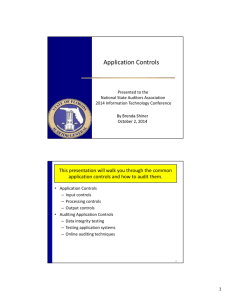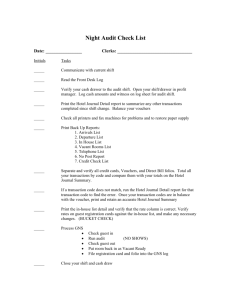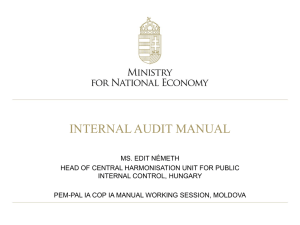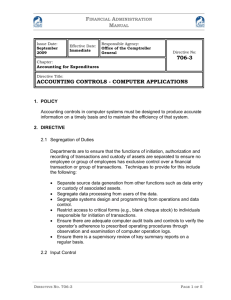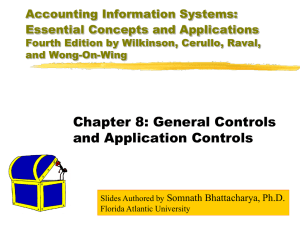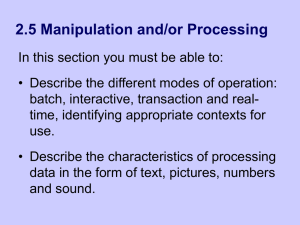Application Controls 06-17-2014
advertisement
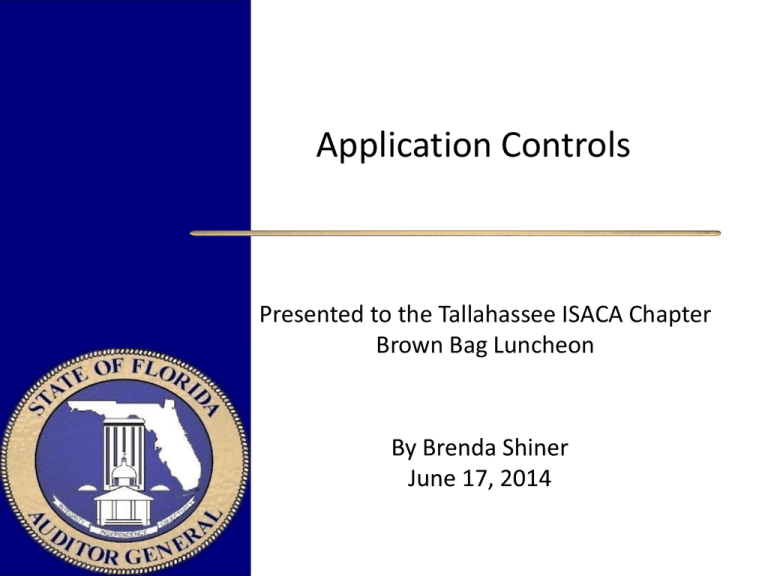
Application Controls Presented to the Tallahassee ISACA Chapter Brown Bag Luncheon This presentation will walk you through the common application controls and how to audit them. • Application Controls – Input controls – Processing controls – Output controls • Auditing Application Controls – Data integrity testing – Testing application systems – Online auditing techniques 2 Application controls are controls over input, processing, and output functions. • Only complete, accurate, and valid data are entered and updated in a computer system • Processing accomplishes the correct task • Processing results meet expectations • Data is maintained 3 Application controls can be automated or manual. Application controls include: • Edit tests • Totals • Reconciliations • Identification and reporting of missing or exception data • Automated controls combined with manual controls 4 Application controls help ensure data accuracy, completeness, validity, verifiability, and consistency, thus achieving data integrity and reliability. Application controls ensure: • System integrity • System functions as intended • Information in the system is relevant, reliable, secure, and available as needed 5 Input or origination controls ensure that every transaction is entered, processed, and recorded accurately and completely. Types of input controls include: • Input authorization • Batch controls and balancing • Error reporting and handling 6 Input authorization controls verify that all transactions have been authorized and approved by management. Input authorization controls: • Signatures on batch forms or source documents • Online access controls • Unique passwords • Terminal or workstation identification • Source documents 7 Batch controls combine input transactions into groups or batches to provide control totals that are matched to the source documents to verify that the entire batch was processed. Batch controls include: • Total monetary amount • Total items • Total documents • Hash totals 8 Batch balancing controls can be performed through either a manual or automated reconciliation. Batch balancing controls must be combined with adequate follow-up procedures. Batch balancing controls include: • Batch registers • Control accounts • Computer agreement 9 Input error reporting and handling ensures only correct data are accepted into the system and input errors are identified and corrected. Input error reporting and handling can be processed by: • Rejecting transactions with errors • Rejecting the whole batch • Holding batches in suspense • Accepting the batch and flagging error transactions 10 Input processing requires that controls be identified to verify that only correct data are accepted into the system. Input processing control techniques include: • Transaction logs – detailed listings of all updates which can be manually maintained or automatically generated through computer logs • Reconciliation of data – ensures all data are properly recorded and processed • Documentation – written evidence of control procedures • Anticipation – user groups anticipate the receipt of data • Transmittal log – documents the transmission or receipt of data • Cancellation of source documents – prevents duplicate entry 11 Input processing also requires that controls be identified to ensure that input errors are recognized and corrected. Error correction procedures include: • Logging of errors • Timely corrections • Upstream resubmission • Approval of corrections • Suspense file • Error file • Validity of corrections 12 Processing procedures and controls are meant to ensure the reliability of application program processing. Processing procedures and controls include: • Data validation and edits • Processing controls • Data file control procedures 13 Data validation and edit procedures ensure input data is validated as close to the point of origination as possible. • Limit check – benefits check should not exceed a certain amount • Range check – students registering for a certain grade should be in a certain age range • Validity check – the zip code matches the state in the address • Sequence check – the check number being paid matches the range of issued checks 14 Data validation and edit procedures identify errors, incomplete or missing data, and inconsistencies among related data items and ensures only accurate data are processed. • Existence check – a product number matches a product being sold • Completeness check – all required fields are required to be filled in • Duplicate check – a duplicate purchase order is identified • Logical relationship check – the credit card number has been provided if the payment is by credit card 15 Processing controls are meant to ensure the completeness and accuracy of accumulated processed data. • Edit checks – most of the data validation examples would also work as edit checks • Manual recalculation – perform a recalculation of a sample of transactions to verify the accuracy of calculations, for example, sales tax • Run-to-Run totals – control totals are maintained through various states of processing to verify the completeness of the records • Exception Reports – reports programmatically identify transactions or data that fall outside a predetermined range or do not match other specified criteria 16 Data file control procedures ensure that only authorized processing occurs in stored data. • • • • • • • Data file security – ensures only authorized users have access to alter the data through either access to the application or direct access to the database Source documentation retention – source documents retained for an adequate time period to enable retrieval, reconstruction, and verification of data if necessary Version usage – make sure that the correct, current version of a file is being used Internal and external labels – use on removable media and files to ensure the correct data is being used File updating and maintenance authorizations – ensures that maintenance follows an approved and documented process Transaction logs – useful in tracking down which transactions were processed in the event of an error and investigating the cause Before and after image reporting – useful as a monitoring tool while not as granular as the transaction log 17 Output controls are meant to provide assurance that the data delivered to users will be presented, formatted, and delivered in an accurate, consistent, and secure manner. • Tracking of sensitive output: – Negotiable instruments – Confidential information – Etc. • Report distribution control • Output error handling • Reconciliation of control counts/totals 18 The starting point for auditing application controls is identifying significant application components and the flow of information through the system. • • • • Understand transaction flow Assess application risks Test user controls Test data integrity The impact of control weaknesses can be evaluated by reviewing available documentation and interviewing appropriate personnel. 19 An analysis of the transaction flow will allow for an understanding of potential weak points where the controls should be reviewed. • • • • • • • Points where transactions and data are entered Points where transaction calculations are performed Points where data transformations occur Points where transactions are posted Points where databases are updated Points where reports are generated Points where data are transmitted 20 A risk assessment can be based on a variety of factors and can assist in focusing your audit on the inherent risks of an application. • • • • • • • • Recent application changes Time elapsed since last audit Complexity of operations Changes in operations/environment Transaction volume Monetary value of transactions Sensitivity of transactions Impact of application failure 21 Key user controls may be directly tested to determine if they are performing as intended. • • • • • Review and testing of access authorizations and capabilities Separation of duties Error control and correction Activity and violation reporting Distribution of reports 22 Data integrity tests examine the accuracy, completeness, consistency, and authorization of data presently held in a system. • Determine if data validation routines are functioning correctly • Determine if database tables are properly defined and applying appropriate input constraints and data characteristics • Ensure referential integrity for primary and foreign keys in tables Data integrity tests will indicate failures in input or processing controls. 23 Data integrity testing is a set of substantive tests that examines accuracy, completeness, consistency, and authorization of data presently held in a system. • Relational integrity tests - performed at the data element and record-based levels and enforced through data validation routines built into the application or by defining the input condition constraints and data characteristics at the table definition in the database stage • Referential integrity tests - define existence of relationships between entities in different tables of a database that need to be maintained by the Database Management System (DBMS) 24 In multi-user transaction systems, it is necessary to manage parallel user access to stored data typically controlled by a DBMS and deliver fault tolerance. Of particular importance are four online data integrity requirements known collectively as the ACID principle: • Atomicity - from a user perspective, a transaction is either completed in its entirety (i.e., all relevant database tables are updated) or not at all • Consistency - all integrity conditions in the database are maintained with each transaction, taking the database from one consistent state into another consistent state • Isolation - each transaction is isolated from other transactions and hence each transaction only accesses data that are part of a consistent database state • Durability - if a transaction has been reported back to a user as complete, the resulting changes to the database survive subsequent hardware or software failures 25 Testing the effectiveness of application controls involves analyzing computer application programs, testing computer program controls, and selecting and monitoring transactions. Methods and techniques for testing application systems include: • Snapshot • Mapping • Tracing and tagging • Test data/deck • Base-case system evaluation • Parallel operation • Integrated testing facility • Parallel simulation • Transaction selection programs • Embedded audit data collection • Extended records 26 Continuous online auditing is becoming increasingly important in today's e-business world. • Allows IS auditors to monitor the operation of systems on a continuous basis while normal processing takes place and gather selective audit evidence through the computer • Cuts down on needless paperwork and leads to the conduct of an essentially paperless audit 27 There are five types of automated evaluation techniques applicable to continuous online auditing. • Systems Control Audit Review File and Embedded Audit Modules (SCARF/EAM) • Snapshots • Audit hooks • Integrated test facility (ITF) • Continuous and intermittent simulation (CIS) 28 The selection and implementation of continuous audit techniques depends, to a large extent, on the complexity and understanding of an organization's computer systems and applications. Continuous Audit Technique Useful When: Systems Control Audit Review File and Embedded Audit Modules (SCARF/EAM) Regular processing cannot be interrupted Snapshots An audit trail is required Audit hooks Only select transactions or processes need to be examined Integrated test facility (ITF) It is not beneficial to use test data Continuous and intermittent simulation (CIS) Transactions meeting certain criteria need to be examined 29 Questions? 30
